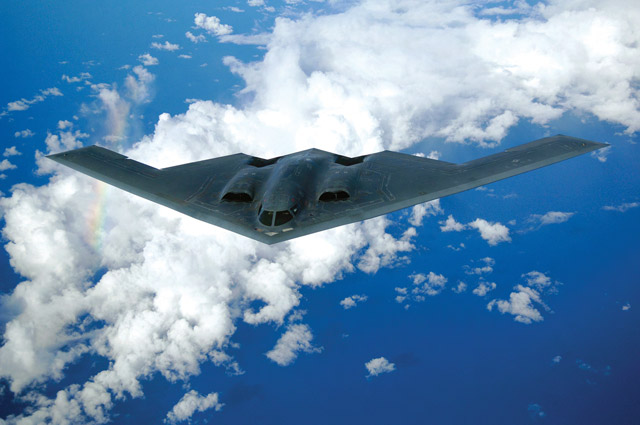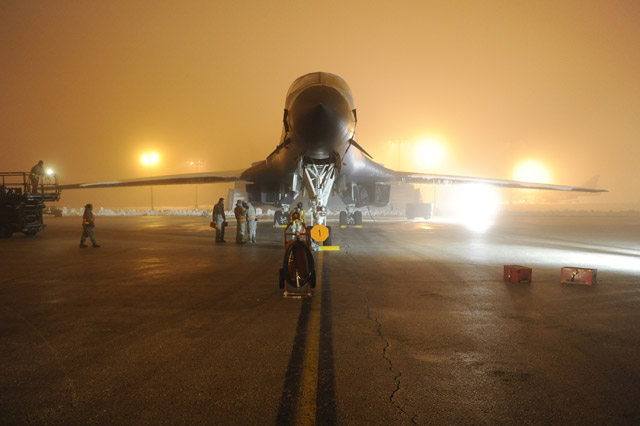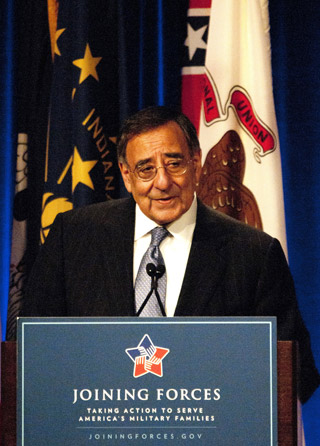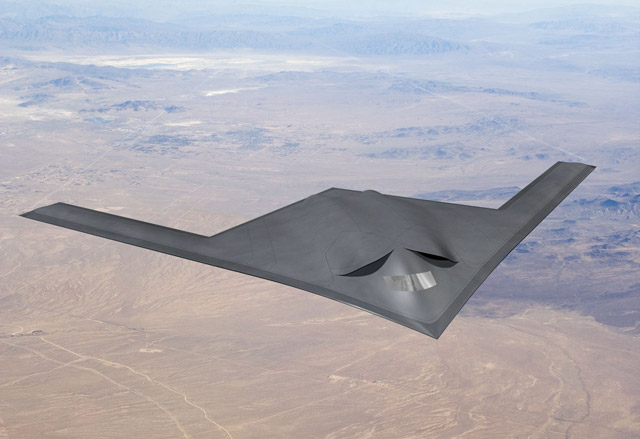The US Air Force is developing a new stealth bomber to counter growing anti-access/area-denial (A2/AD) challenges around the world - but the programme faces enormous challenges in the face of declining US defence outlays. The Long Range Strike-Bomber (LRS-B) is part of a so-called "family of systems" being designed to ensure US forces can hold any point on Earth that may be at risk from aerial attack. The Long Range Strike family of systems - particularly the new bomber - is the centrepiece of the Pentagon's emerging "AirSea Battle" construct.
 |
|---|
| US Air Force The US Air Force's 20-strong fleet of B-2 stealth bombers is likely to struggle in the face of new enemy air defence systems |
On 17 February, US secretary of defense Leon Panetta told a mainly air force audience at Barksdale AFB, Louisiana that maintaining the USA's bomber fleet was "extremely important" as was "putting money into developing a new bomber - so we're going to do both of those". "We're going to maintain this bomber fleet. We're going to keep it in place. We need it for forward projection. We need it for power projection in the Pacific; we need it for power projection in the Middle East," he added.
The LRS-B project is considered so important to future US military strategy in the Western Pacific and Middle East that the programme is proceeding despite a $487 billion reduction in the Pentagon's budget covering the next 10 years.
INVESTMENT DECISIONS
"For each of our strategic initiatives we have had to make careful investment decisions in light of our fiscal responsibilities," deputy secretary of defense Ashton Carter said at the Air Force Association's annual convention in September. "We've had to weigh costs and measure benefits. We're investing in capabilities we need for the future, like the new stealth bomber."
However, despite strong support from senior leaders at the Pentagon, it is unclear if the LRS programme will survive a "sequestration" budget-cutting measure, which will come into effect on 2 January. If Congress and the president are unable to find a solution, another $500 billion will be cut from the US defence budget in the next 10 years. If that happens, "all bets are off", says Mark Gunzinger, an analyst at the Center for Strategic and Budgetary Assessments and a former Boeing B-52 pilot.
The LRS programme was allocated $197 million in fiscal year 2012. In the FY2013 budget, the programme is funded at $300 million. During the Pentagon's five-year budget plan ending in FY2017, the LRS is projected to receive $6.3 billion. However, that is only a fraction of the funding needed for the new bomber to become reality, especially with the USAF's stated goal to declare the aircraft operational by 2025.
"The last five-year plan saw an impressive ramp-up for [bomber] funding, but it basically covers about 10% of the total development bill through 2017," says Richard Aboulafia, an analyst at the Teal Group. "In other words, they need an even more impressive ramp-up in the coming years if they want IOC [initial operational capability] in 2025, with about $5-6 billion per year in the second half of the decade."
Based on the experience of the Lockheed Martin F-22 Raptor and the F-35 Joint Strike Fighter, the cost of developing the new bomber could be as much as $60 billion. "Given the budget environment, that's going to be a very tough sell," Aboulafia says. "The likeliest outcome, predictably, is a funding stretch out, which results in IOC around 2030."
The USAF maintains it will use "mature technologies" in the LRS-B, which could reduce the cost of development. "The new bomber will incorporate many subsystems [engines, radars, other avionics] and technologies that are already proven," a Pentagon budget justification document states.
Moreover, the new bomber could re-use parts from other aircraft such as the Northrop Grumman B-2's landing gear and other off-the-shelf components in the same manner the Lockheed F-117 Nighthawk once did. The USAF is also using a different acquisition process: the programme is being run through the service's Rapid Capabilities Office.
Gunzinger considers the Department of Defense's projected unit cost of $550 million a conservative target. "I'm optimistic about the cost," he says. In Gunzinger's view, the key to an affordable LRS-B is strict discipline on the requirements imposed on the aircraft: "Fix your requirements early, then let industry do what it does best - and that is to figure out capabilities solutions."
 |
|---|
| US Air Force The USAF's B-1B fleet has lost its nuclear strike role, while the swing-wing type also cannot penetrate heavily defended airspace |
Cautionary examples are at hand. If the USAF continually changes or adds ever more elaborate requirements, the LRS-B could suffer the same fate as previous USAF bomber projects such as the B-2 or the ill-fated Next Generation Bomber (NGB), which was cancelled in 2009. Without discipline, there is great potential for the service to go astray, warns Loren Thompson, an industry consultant and chief operating officer at the Lexington Institute. The USAF, he notes, hopes to build the LRS-B as an optionally manned aircraft. "Tell me you're really going to send an aircraft that costs the better part of a billion dollars into hostile territory without human pilots in it," he says.
OPTIONALLY MANNED
Unmanned air vehicles have a far higher accident rate than manned aircraft, even in peacetime. When faced with an A2/AD threat, communications can become an enormous challenge if datalinks and satellite links needed to maintain control of a UAV are attacked. And without a human in the cockpit, reaction times suffer during a communications lag. "The further away that you separate a human being's brain from the operation of a system, the greater vulnerabilities you inject into that system," argues retired Lt Gen David Deptula, former USAF intelligence chief.
With an aircraft the size of a strategic bomber, there is little cost difference between a purely manned and an optionally manned aircraft, says Gunzinger: "For large combat aircraft, it is not much of a factor at all."
Rebecca Grant, an analyst at IRIS Independent Research, thinks the potential contractors - Boeing, Lockheed and Northrop - will have already been told the basic parameters sought for the LRS-B, including the radar cross-section and other low-observable characteristics, plus payload, range and altitude. Many parameters will be drawn from earlier work on the NGB, but details are closely guarded secrets. By necessity of its mission, the LRS-B is likely to be designed with global range and persistence, Gunzinger predicts. It will therefore be a large, stealthy aircraft with a hefty payload.
For range and payload, a departure from the NGB - a medium-sized bomber with a combat radius of 2,000-2,500nm (3,700-4,620km), translating into a 4,000-5,000nm range - was inevitable. "The air force desperately needs a new bomber, but they didn't need the kind of bomber the air force was developing," Thompson says of the NGB.
Supersonic dash capability could increase the aircraft's survivability but would add to cost and complexity, and might require other performance trade-offs, says Gunzinger. Earlier in the year, then-USAF chief of staff Gen Norton Schwartz said the service had not asked for supersonic capability. He said the aircraft would be supported by a "family of systems", which could include US Navy Raytheon Tomahawk cruise missiles, Boeing EA-18G Growlers, Unmanned Carrier-Launched Airborne Surveillance and Strike aircraft, USAF F-22s and F-35s, miniature air-launched decoys, satellites and cyber-warfare assets.
 |
|---|
| Rex Features "We're going to maintain this bomber fleet. We need it for forward projection" Leon Panetta |
The bomber is likely to be designed to carry a range of direct attack or stand-off weapons. Those will include conventional and nuclear weapons, although USAF leaders have said the LRS-B will only be certificated for the nuclear mission when older bombers start leaving the inventory. Conducting offensive operations against a robust air defence system using only stand-off weapons is expensive and unsustainable, argues Deptula.
ADAPABILITY
Given that the B-52 has been soldiering on for more than 50 years, Gunzinger says the new aircraft needs to be adaptable to technologies and threats as they appear. But adaptability only goes so far. Gunzinger says that while certain systems such as sensors and low-observable coatings can be rapidly upgraded, some systems, such as engines, need to remain fixed. The USAF says it wants 80 to 100 LRS-B aircraft, but Deptula argues that the service should buy at least 155 - enough to fill 10 squadrons with 12 aircraft each. Grant sees a need for 200 aircraft to replace the entire fleet of B-52s, B-2s and Boeing B-1s. "When you look at the aircraft China can put in the air, you want a credible force that isn't going to be chipped away," she says.
The USAF has little choice but to buy a new bomber. The B-52 is not only ageing but is unable to penetrate enemy air defences. The B-1B is more modern, but the remaining fleet of about 60 aircraft cannot break into heavily defended airspace. Moreover, the type has been "de-nuclearised" and can only perform a conventional strike role. Only the tiny fleet of 20 B-2A Spirit stealth bombers have the ability to operate inside enemy air defences to any degree - but even they are starting to struggle.
 |
|---|
| Boeing The ill-fated Next Generation Bomber was cancelled in 2009 |
"The reality is that the B-2 over time is going to become less survivable in contested airspace," Schwartz told Congress on 28 February. "The technology on which they were designed, with respect to signature management is e_SSRq80s vintage." This means the USAF needs to recapitalise the bomber fleet by the 2030s, if not sooner, Aboulafia says. "Only the B-2s will make it beyond 2040," he adds. "So I think this is real, despite the huge budget challenges."
The USAF refuses to officially comment on the LRS-B, with the developmental effort being run as a "black programme". The service is so concerned with security it will not confirm if a programme office has been set up, or even if there will be a competition to build the new aircraft.
"Specific LRS-B programmatic details are protected with enhanced security measures," the air force says.
- Follow Flightglobal's take on all the defence sector news at our blog The DewLine
Source: Flight International



















